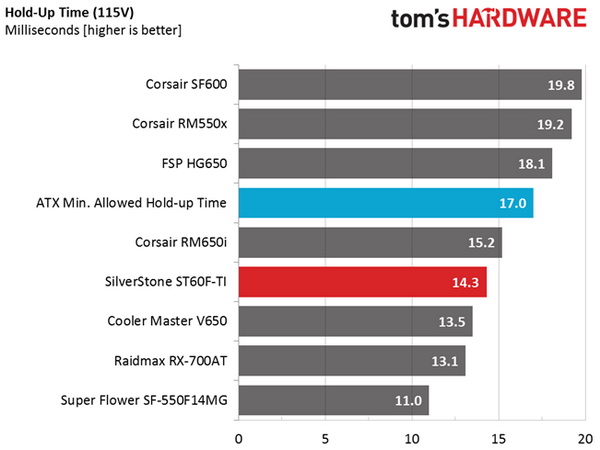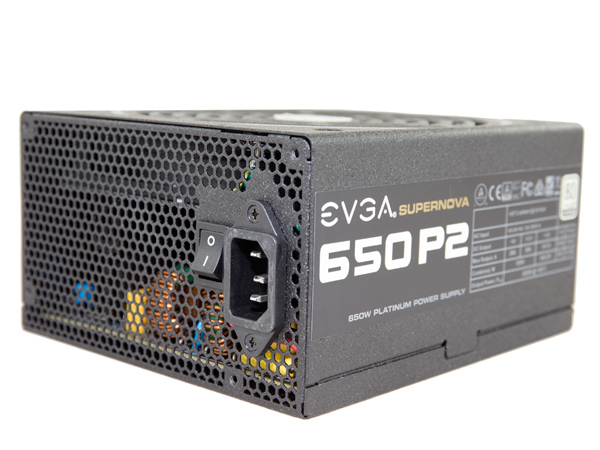SilverStone Strider Titanium ST60F-TI PSU Review
SilverStone released its first Titanium PSU series, which is made by Enhance Electronics. The smallest Strider Titanium unit will be under our scope today. Besides high efficiency it also offers compact dimensions and a fully modular cable design.
Why you can trust Tom's Hardware
Load Regulation, Hold-Up Time And Inrush Current
To learn more about our PSU tests and methodology, please check out How We Test Power Supply Units.
Primary Rails And 5VSB Load Regulation
Load Regulation testing is detailed here.








Hold-Up Time
Our hold-up time tests are described in detail here.







Not only is the hold-up time lower than 17ms, but the power-good signal also lasts much longer. When it drops, the rails are already out of spec. This is a major downside for a PSU, especially a high-end one.
Inrush Current
For details on our inrush current testing, please click here.


The inrush current is pretty high, mainly with 115VAC input.
Load Regulation And Efficiency Measurements
The first set of tests reveals the stability of the voltage rails and the PSU's efficiency. The applied load equals (approximately) 10 to 110 percent of the maximum load the supply can handle, in increments of 10 percentage points.
Get Tom's Hardware's best news and in-depth reviews, straight to your inbox.
We conducted two additional tests. During the first, we stressed the two minor rails (5V and 3.3V) with a high load, while the load at +12V was only 0.10A. This test reveals whether a PSU is Haswell-ready or not. In the second test, we determined the maximum load the +12V rail could handle with minimal load on the minor rails.
| Test # | 12V | 5V | 3.3V | 5VSB | DC/AC (Watts) | Efficiency | Fan Speed (RPM) | FAN Noise (dB[A]) | Temps (In/Out) | PF/AC Volts |
|---|---|---|---|---|---|---|---|---|---|---|
| 1 | 3.212A | 1.994A | 1.969A | 1.000A | 59.80 | 90.58% | 835 | 26.8 | 37.29 °C | 0.920 |
| 11.899V | 5.012V | 3.350V | 4.987V | 66.02 | 39.80 °C | 115.1V | ||||
| 2 | 7.475A | 2.990A | 2.960A | 1.203A | 119.74 | 92.86% | 1110 | 32.3 | 37.70 °C | 0.954 |
| 11.893V | 5.005V | 3.341V | 4.978V | 128.95 | 40.46 °C | 115.1V | ||||
| 3 | 12.095A | 3.507A | 3.476A | 1.405A | 179.87 | 93.12% | 1480 | 40.5 | 39.18 °C | 0.973 |
| 11.887V | 4.998V | 3.334V | 4.968V | 193.17 | 42.48 °C | 115.1V | ||||
| 4 | 16.712A | 4.006A | 3.965A | 1.610A | 239.73 | 93.02% | 1805 | 46.0 | 39.64 °C | 0.977 |
| 11.882V | 4.989V | 3.327V | 4.958V | 257.73 | 43.30 °C | 115.1V | ||||
| 5 | 20.986A | 5.011A | 4.972A | 1.815A | 299.67 | 92.71% | 1965 | 45.8 | 40.39 °C | 0.983 |
| 11.876V | 4.982V | 3.318V | 4.949V | 323.22 | 44.65 °C | 115.1V | ||||
| 6 | 25.267A | 6.035A | 5.983A | 2.020A | 359.71 | 92.28% | 2200 | 48.7 | 41.10 °C | 0.985 |
| 11.870V | 4.974V | 3.308V | 4.940V | 389.80 | 45.99 °C | 115.1V | ||||
| 7 | 29.548A | 7.043A | 7.001A | 2.230A | 419.63 | 91.37% | 2280 | 48.8 | 42.24 °C | 0.987 |
| 11.864V | 4.966V | 3.299V | 4.932V | 459.27 | 47.68 °C | 115.1V | ||||
| 8 | 33.837A | 8.070A | 8.022A | 2.436A | 479.63 | 90.82% | 2280 | 48.8 | 43.48 °C | 0.990 |
| 11.858V | 4.958V | 3.290V | 4.921V | 528.10 | 49.50 °C | 115.1V | ||||
| 9 | 38.569A | 8.580A | 8.558A | 2.439A | 539.74 | 90.39% | 2280 | 48.8 | 44.01 °C | 0.991 |
| 11.853V | 4.953V | 3.283V | 4.917V | 597.12 | 50.48 °C | 115.1V | ||||
| 10 | 43.247A | 9.097A | 9.065A | 2.544A | 599.57 | 89.84% | 2280 | 48.8 | 45.20 °C | 0.992 |
| 11.848V | 4.946V | 3.276V | 4.909V | 667.35 | 52.21 °C | 115.1V | ||||
| 11 | 48.326A | 9.103A | 9.079A | 2.545A | 659.53 | 89.31% | 2280 | 48.8 | 45.72 °C | 0.992 |
| 11.844V | 4.942V | 3.270V | 4.906V | 738.51 | 53.32 °C | 115.1V | ||||
| CL1 | 0.100A | 12.010A | 12.005A | 0.004A | 100.84 | 86.51% | 2280 | 48.8 | 44.25 °C | 0.952 |
| 11.900V | 4.987V | 3.310V | 5.049V | 116.57 | 48.70 °C | 115.1V | ||||
| CL2 | 48.956A | 1.003A | 1.003A | 1.002A | 593.39 | 90.47% | 2280 | 48.8 | 44.94 °C | 0.992 |
| 11.850V | 4.970V | 3.310V | 4.945V | 655.88 | 51.84 °C | 115.1V |
Load regulation at +12V is super tight, especially for a Titanium-rated PSU. Usually, compromises have to be made to enable low energy losses. Regulation is good on the 5V and 5VSB rails as well, while at 3.3V the deviation is within 2.5 percent.
But let's skip to the important part: this PSU's efficiency levels. Under 10 percent load, the 90 percent efficiency mark is passed; the same goes for our 20 percent load test. With 50 percent load, we should measure at least 94 percent efficiency. Instead we get a much lower reading of 92.71 percent, though. Finally, under full load, the PSU approaches 90 percent so we're giving it a pass. Obviously the low reading at 50 percent load has to do with high ambient temperatures compared to the conditions used by the 80 PLUS organization. No doubt this is a highly efficient PSU, though we've seen Titanium-rated units scoring better.
The fan profile becomes aggressive once the PSU's operating temperature exceeds 35 °C. So, only during the first two tests noise is kept at low levels. Under 40 percent load and up, the acoustics worsen. We also noticed an increased fan bearing noise during the 40 and 60 percent tests. Finally, the PF readings are pretty high, even during the first test where the load level is only 60W.
Current page: Load Regulation, Hold-Up Time And Inrush Current
Prev Page A Look Inside And Component Analysis Next Page Efficiency, Temperature And Noise
Aris Mpitziopoulos is a contributing editor at Tom's Hardware, covering PSUs.
-
JamesSneed So essentially this is a overpriced PSU with to much ripple. This left me wondering why the EVGA SuperNova 850 T2 was not in the charts. You mentioned the SuperNova towards the end and it just seems like the proper competitor since its another TI rated PSU.Reply -
Jack_565 Nice to see a review on at least one of the Strider Titanium units.Reply
I recently purchased a 800w Version(these are the only Titanium PSUs in the Australian Market under 1000w) and its been everything i've wanted, running at almost 50% load it gives me its peak efficiency which is exactly why i paid the premium to get a Titanium PSU.
I can see the 600w version being a more commonly purchased unit with the way power consumption has dropped, Skylake Rigs only use around 300w(give or take variables) which would be the Striders peak efficiency. -
turkey3_scratch Jonnyguru also did a review on the same unit here, so the "high" ripple is consistent among these units. Probably due to a lack of filter capacitors, either to increase efficiency or conserve space. I'd like to see how the efficiency would be improved if they used a relay.Reply
What I don't understand is the small transformer. Aris, you mentioned that this unit, to have higher efficiency, switches to not-as-high of a frequency (which also affects transient response negatively). Since transformer size is inversely proportional to the AC frequency, wouldn't the transformer have to be larger? Is there any downside to a smaller transformer?
Yet again, more PWR_OK cheaters. It seems like at least one in two PSUs are like this. I agree that no power switch on this unit seems very silly to me. -
Aris_Mp The switching frequency probably isn't as high in order to achieve the higher possible efficiency, but this doesn't necessary means that it isn't high enough to allow for a small main transformer. In addition the design of the transformer plays a key role also in this.Reply


